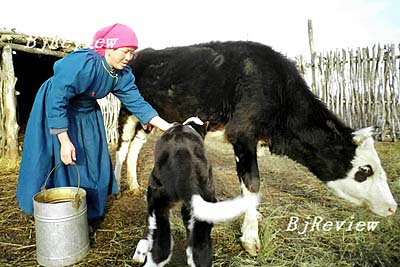|

Zu Wei, Director General of the Livestock Farming and Veterinary Bureau of Heilongjiang Province, is happier recently after finding out the State Council will give further support to the dairy industry. A document enacted on September 29 offers specific policy-related solutions to promote the sustainable and healthy development of the dairy sector, including increasing subsidies to cow breeders and for milking machines, and providing a special policy-related agricultural insurance.
"The Central Government has made explicit its duties and policies to support the dairy sector, which is undoubtedly good news," said Zu. "It comforts the cow breeders and boosts their confidence."
Heilongjiang Province is one of the major cattle breeding regions in China, host to nationally famous dairy brands like Wonder Sun Dairy. As a livestock farming official, Zu has put great faith in policy-related supports. He hopes the enactment of the policy will boost falling purchase prices for milk as well as the dairy sector in Heilongjiang Province as a whole.
Zu said the dairy sector is working on an integrated approach for the dairy chain, encouraging direct cooperation between milk processing factories and farmers with societies of cow breeders, or by using dairy associations as the matchmaker between the separate parts of the industry.
Other cow breeders throughout China's breeding provinces and regions are elated with the supportive policies. In the past year, the raw milk market had shrunk and the new policy supports give hope to individual cow breeders.
Currently, the State Council is working on detailed implementation measures for the supports. They are expected to go into effect by the end of this year.
Udder despair
Chen Daping, a villager in Niangetu Village in Hohhot, capital of Inner Mongolia Autonomous Region, has bred cows for over a dozen years. His village was among the first group of raw milk bases established in Inner Mongolia. Buyers from China's major dairy producers including Mengniu and Yili often go to Chen for raw milk.
Chen's several dozen cows used to be his major source of income. But they have become a burden since last year when the grain price hike created an increase in feed prices. The price for concentrated feed jumped from 1.5 yuan per kg last year to 2.1 yuan per kg in June this year and the hay price skyrocketed from 300 yuan per hectare to 1,500 yuan per hectare.
It generally takes 25 months for a cow to mature to the point of providing milk for about seven consecutive years and a milk cow can eat up around 50 kg of fodder every day. As a result, the feed expense for a cow capable of providing 5 tons of milk is 2,000 yuan more than it was in 2004.
These added expenses come at a time when the purchase price for raw milk only increased from 1.73 yuan per kg in 2004 to 1.84 yuan per kg in 2006. This means the sale price for 5 tons of milk only increased by 300 yuan.
The two factors combined have already cut the income off one milk cow by 1,700 yuan. In addition, increases in other expenses such as covering epidemic control, transportation, water and electricity, have helped reduce profits to their nadir.
"We gained 2,000-3,000 yuan from each cow several years ago, but now we only hope that it costs us less," said Chen. Because of these tough times, Chen had to sell cows yielding less than 15 kg of milk a day to the slaughterhouse for about 4,000 yuan. Just a few years ago he'd spent over 10,000 yuan to purchase them.
Many breeders have resorted to that alternative, including those in Shanyin County in Shanxi Province. As a result of the large-scale slaughter in May, the number of cows in Shanyin County dropped by more than 7,000 in early June.
In July, an investigation team made up of members from the Development Research Center of the State Council, the Ministry of Agriculture and the Ministry of Commerce discovered on field trips that 40 percent of the cow breeders nationwide are suffering losses at varying degrees, 30 percent are managing to subsist, and only 30 percent are making a profit.
Raw milk shortage
Milk cows have been slaughtered and sold as beef cattle, resulting in a sharp reduction in the number of cows and a shortage of raw milk.
According to Chen, the village once had around 4,000 cows at its peak. Those numbers have shrunk quickly since 2005 and are estimated to be at less than 2,800 at present. Because of this, milk production has suffered. One milking shed in the village that used to collect 7 tons of milk from villagers now yields 3 tons at most.
The milk shortage severely threatens the construction of raw milk bases and the sustainability of the dairy industry.
The purchase price for raw milk has increased since August due to the shortage and some milking sheds have had to send workers directly to cow breeders for milk. Statistics from the Dairy Association of China (DAC) shows the purchase price for raw milk exceed 2.2 yuan per kg in Ningxia Hui Autonomous Region, 2.3 yuan per kg in northeast China and 2.9 yuan per kg in Shanghai. Milk
| 